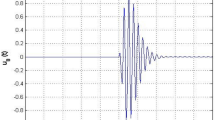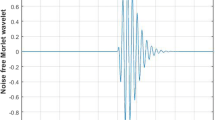Abstract
In this study, a new inversion method is presented for performing one-dimensional Fourier transform, which shows highly robust behavior against noises. As the Fourier transformation is linear, the data noise is also transformed to the frequency domain making the operation noise sensitive especially in case of non-Gaussian noise distribution. In the field of inverse problem theory it is well known that there are numerous procedures for noise rejection, so if the Fourier transformation is formulated as an inverse problem these tools can be used to reduce the noise sensitivity. It was demonstrated in many case studies that the method of most frequent value provides useful weights to increase the noise rejection capability of geophysical inversion methods. Following the basis of the latter method the Fourier transform is formulated as an iteratively reweighted least squares problem using Steiner’s weights. Series expansion was applied to the discretization of the continuous functions of the complex spectrum. It is shown that the Jacobian matrix of the inverse problem can be calculated as the inverse Fourier transform of the basis functions used in the series expansion. To avoid the calculation of the complex integral a set of basis functions being eigenfunctions of the inverse Fourier transform is produced. This procedure leads to the modified Hermite functions and results in quick and robust inversion-based Fourier transformation method. The numerical tests of the procedure show that the noise sensitivity can be reduced around an order of magnitude compared to the traditional discrete Fourier transform.










Similar content being viewed by others
References
Amundsen L (1991) Comparison of the least-squares criterion and the Cauchy criterion in frequency-wavenumber inversion. Geophysics 56:2027–2038
Dobróka M, Gyulai A, Ormos T, Csókás J, Dresen L (1991) Joint inversion of seismic and geoelectric data recorded in an under-ground coal mine. Geophys Prospect 39:643–665
Dobróka M, Szegedi H, Vass P, Turai E (2012) Fourier transformation as inverse problem—an improved algorithm. Acta Geod Geophys Hung 47(2):185–196. doi:10.1556/AGeod.47.2012.2.7
Dobróka M, Szegedi H (2014) On the generalization of seismic tomography algorithms. Am J Comput Math 4(1):37–46. doi:10.4236/ajcm.2014.41004
Duoandikoetxea J (1995) Fourier analysis. In: Graduate studies in mathematics, vol 29. American Mathematical Society, Providence
Gröbner W, Hoffreiter N (1958) Integraltafel. Zweiter Teil. Bestimmte Integrale. Springer, Wien und Innsbruck
Sauerländer S, Kätker J, Räkers E, Rüter H, Dresen L (1999) Using random walk for on-line magnetic surveys. Eur J Environ Eng Geophys 3(2):91–102
Scales JA, Gersztenkorn A, Treitel S (1988) Fast Lp solution of large, sparse, linear systems: application to seismic travel time tomography. J Comput Phys 75:314–333
Steiner F (1988) Most frequent value procedures (a short monograph). Geophys Trans 34:139–260
Steiner F (1997) Optimum methods in statistics. Academic Press, Budapest
Szűcs P, Civan F, Virag M (2006) Applicability of the most frequent value method in groundwater modelling. Hydrogeol J 14:31–43. Springer. doi:10.1007/s10040-004-0426-1
Vaidyanathan PP (2008) Eigenfunctions of the Fourier transform. IETE J Educ 49(2):51–58
Acknowledgments
The investigations were based on the previous research work of the TÁMOP (Project No. 4.2.1.B-10/2/KONV-2010-0001) Center of Excellence. The research was partly supported by the Hungarian Research Fund OTKA (Project No. K109441). The second author was supported from the TÁMOP 4.2.4. A/2-11-1-2012-0001 National Excellence Program—Elaborating and operating an inland student and researcher personal support system convergence program. The project was subsidized by the European Union and co-financed by the European Social Fund. The authors thank the editor and two anonymous reviewers for their constructive comments, which helped us to improve the manuscript.
Author information
Authors and Affiliations
Corresponding author
Rights and permissions
About this article
Cite this article
Dobróka, M., Szegedi, H., Molnár, J.S. et al. On the Reduced Noise Sensitivity of a New Fourier Transformation Algorithm. Math Geosci 47, 679–697 (2015). https://doi.org/10.1007/s11004-014-9570-x
Received:
Accepted:
Published:
Issue Date:
DOI: https://doi.org/10.1007/s11004-014-9570-x




